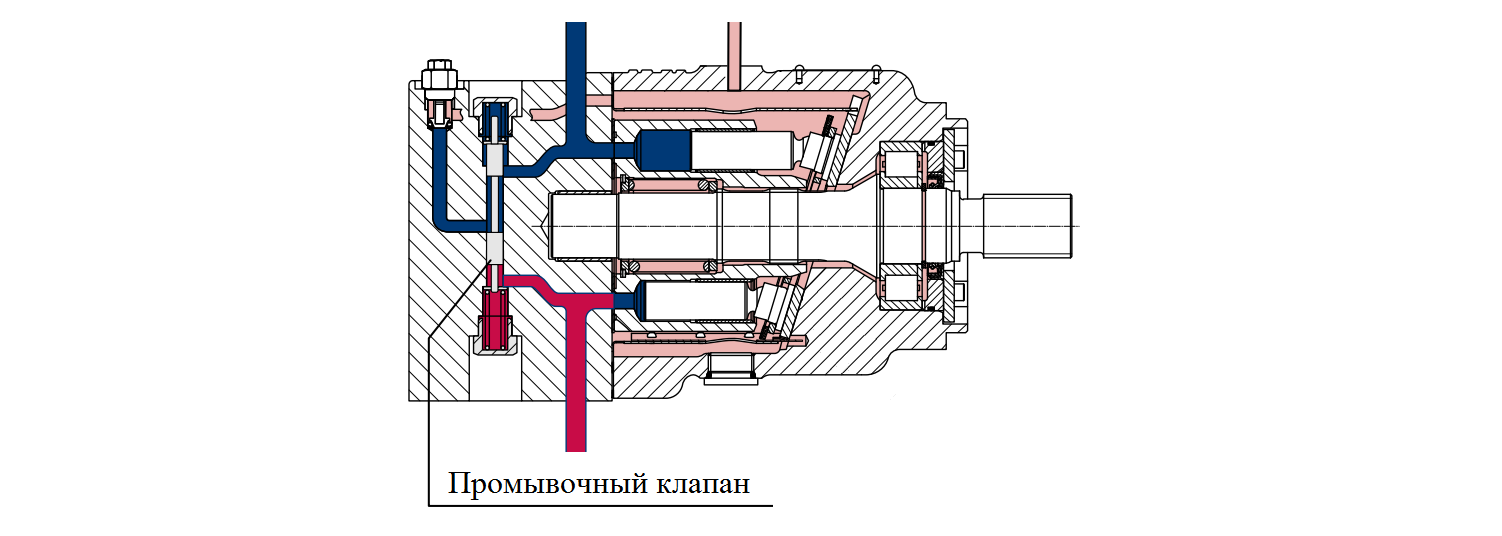Hydrostatic transmission components, liquid cooling
The heat exchanger must provide such heat transfer that you can keep the temperature of the working fluid within the recommended range. This is usually done by selecting the most severe continuous operation and taking into account all heat generation in the transmission under the highest possible ambient temperature conditions. For many machines, this corresponds to the highest output speed allowed by the transmission.

Heat exchanger
The heat exchanger must provide such heat transfer that you can keep the temperature of the working fluid within the recommended range. This is usually done by selecting the most severe continuous operation and taking into account all heat generation in the transmission under the highest possible ambient temperature conditions. For many machines, this corresponds to the highest output speed allowed by the transmission. A rule of thumb is often used to select a heat exchanger with a heat output equal to 1/3 the power of the machine. Testing is strongly recommended to verify that the working fluid temperature remains within the specified range.
The choice of heat exchanger size may affect other components of the hydraulic circuit. In the presence of a flush valve in the system, in general, the heat output required by the heat exchanger is reduced, while the presence of the restrictor valve results in an increase in the heat output required by the heat exchanger. Frequent activation of the safety valve also increases the heat output required by the heat exchanger.
Typically, a heat exchanger bypass line is required to limit back pressure during cold starts.
Circulating flush valve
A hydrostatic transmission has two hydraulic circuits, each with its own function and connected components. This is the main circuit of the system, and also the circuit for cooling and supplying liquid. If the system is equipped with a flush valve, the working fluid circulates between circuits through leaks and flows through the flush valve. The quality of the working fluid is mainly ensured by the make-up/cooling circuit, but the main consumer of high quality working fluid is the main circuit. The flush valve is an important part of the hydraulic system, it controls the supply of high quality working fluid to the main circuit.
Through the flush valve, part of the working fluid flows out of the main circuit and is replenished by the replenishment pump. The working fluid removed from the main circuit may be "dirty" and/or "hot", while the make-up fluid is cold and clean.
The flush valve greatly improves the removal of heat and contaminants from the main circuit, improving the quality of the working fluid and extending the life of the components. While some hydrostatic systems can operate satisfactorily without a flush valve, adding one to the system can greatly improve the operating conditions of primary circuit components that actively generate heat or contaminants.
Danfoss offers flushometers in several configurations. Most closed loop hydraulic motors have an integral flush valve. Separate (remote) flush valves are also available.
The built-in circulating flush valve reduces the number of external components that must be purchased and installed in the system. Additionally, a flush valve built into the hydraulic motor increases working fluid circulation between circuits and improves cooling of the hydraulic motor housing.
Flushometers are recommended in any of the following situations:
Long-term low-pressure high-speed operation. In this mode, higher mechanical losses can be observed, less leakage of working fluid from the main circuit, and therefore a lot of heat generation in the main circuit. Generally, low pressures are less than 1000 psi and high speeds are greater than 2/3 of the rated speed at maximum swashplate angle. In systems operating under these conditions, a hydraulic motor with a built-in flush valve is recommended.
Hydraulic cylinders are present in the hydrostatic circuit. Cylinders can withstand higher concentrations of contaminants than other components of the hydraulic circuit.
Restrictor valve in main circuit. these valves
Heat is generated in the circuit. Note that the flush valve must be located before any split/mix valves in the system.
Frequent activation of the high pressure safety valve can lead to increased heat generation. This also applies to the use of pressure relief valves in hydraulic circuits.
The main circuit pipeline is long. The pressure drop will be higher than usual due to the increased heat generated in the circuit. In general, a pipe is considered long if it is longer than 150 diameters.
Partial filtration of the liquid flow in the supplemental circuit. A flush valve is required to increase the outflow of working fluid from the main circuit and replenish it with cool, clean make-up fluid.
The use of flush valves increases system reliability. Shuttle valves can improve the working conditions of hydraulic system components when there is more scaling or heating. A flush valve built into the hydraulic motor also reduces the length of the crankcase drain from the transmission components to the hydraulic tank. Typically, the use of a flush valve can reduce the size of the heat exchanger.
The final decision is based on an evaluation of the trade-offs between flush valves, heat exchangers, filters, piping configuration and life expectancy.